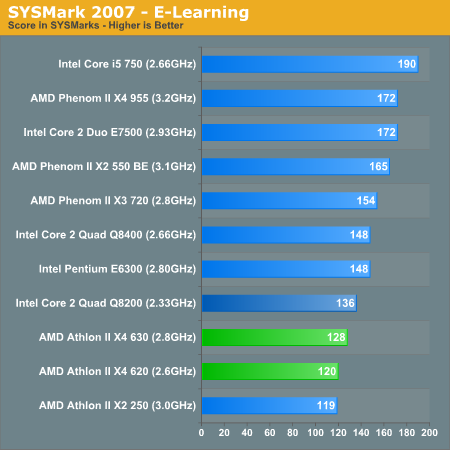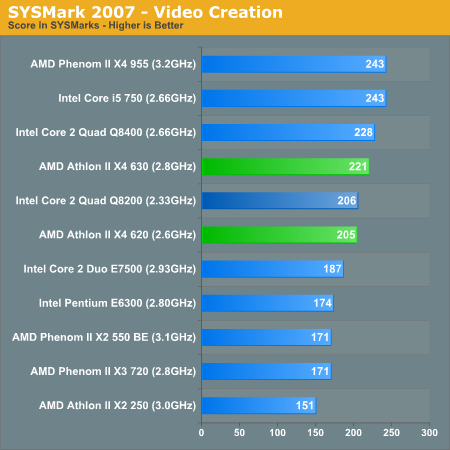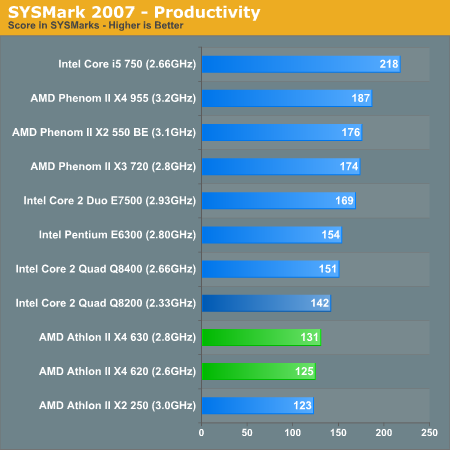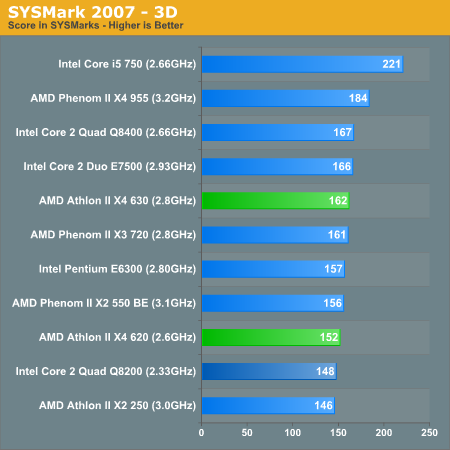AMD Athlon II X4 620 & 630: The First $99 Quad Core CPU
by Anand Lal Shimpi on September 16, 2009 12:00 AM EST- Posted in
- CPUs
SYSMark 2007 Performance
Our journey starts with SYSMark 2007, the only all-encompassing performance suite in our review today. The idea here is simple: one benchmark to indicate the overall performance of your machine.

If we only look at the AMD numbers in this chart, there's a pretty nice lineup going on here. The Athlon II X2 250 is slower than the Athlon II X4 620/630, which is slower than the Phenom II X3 730 and all are slower than the Phenom II X4 955. The performance lines up with the pricing, so all is good.
The problem with these cheap quad-cores has always been that you give up a lot in order to get four cores at a low price. The Athlon II X4 appears to break the mold however. The Athlon II X4 620 is priced at $99 and it performs like a $99 CPU. With the exception of the Core 2 Duo E7500 whose high clock speed makes it do unsually well here, the 620 is balanced. You get a reasonably high clock speed and enough cache to be competitive, both at a good price.
You'll see in the individual tests below that performance varies between competitive and underwhelming depending on the task. Anything that can take advantage of four cores does well, otherwise the smaller L2s of the Athlon II X4 hurt it a bit.

In applications that aren't well threaded, you'll see the Athlon II X4 perform less than stellar - but the same is true for all lower end quad-core CPUs. Even the Q8200 is outperformed by the E6300 here. Situations like this are validation for Intel's aggressive turbo modes on Lynnfield.

Any strenuous video encoding however will seriously favor the Athlon II X4. Here we find the $99 620 tying the Core 2 Quad Q8200, and the 630 outperforming it - all at a lower price.

We're back to needing higher clock speeds and larger caches to compete. Being a quad-core processor isn't easy.











150 Comments
View All Comments
thezorro - Wednesday, September 16, 2009 - link
remember that the lynnfield core i7 750 has turbo overclocking enabled so is overclocked to 3.2 ghz, which is 600 mhz overclocking, while amd processors are running at stock speedIs unfair to present the results this way, turbo is overclocking.
Wivvix - Thursday, September 17, 2009 - link
Sorry but your logic fails. It is a feature of the i7 750, that it runs at slower speeds when idle, as to when the processor is under load.In the same way, fan speed RPM is automatically regulated depending on whether the process is idle or under load.
The maximum clock speed of an i7 750 is 3.2gh. The user doesn't have to change or do anything. This is not overclocking in the sense you purport, and is not unfair. That is the maximum clock speed of the processor out of the box. End of story.
kagenokurei - Wednesday, September 16, 2009 - link
im sorry, but i have to defend thezorro at least this time..overclocking's basic principle is to increase CPU speeds..but if u guys look into it, what u increase is the core clock(GHz,MHz,etc) beyond the factory released specs..voltage increases and other tweaks are only done to make the overclock stable..
now,in this light,i also find it quite unfair to compare the single threaded performance of the i7s with the PII X4s..simply because the i7s can run its single core at a higher clock when the others are idle..therefore,overclocking at least THAT core..w/c of course, the PII X4s are unable to do..
i agree that the Turbo mode is a good feature, and AMD should have something like it on their CPUs..until then, the Turbo mode is kind of an unfair advantage in benchmarking single threaded performance..
jonup - Wednesday, September 16, 2009 - link
Well the PII 965 is an overclocked to 3.4GHz, which is 600MHz overclocking of 920. It's unfair to present the results this way. The 965BE is so obviously OCed because it uses tons more power than the 920.fitten - Wednesday, September 16, 2009 - link
Bzzzt... wrong... when will you fanbois give this up? It's the normal and default behavior of the thing. You can do the academic discussion all you want but normal operation of the chips has Turbo enabled. To test any other way is to test a non-standard, non-default operating mode. You might as well test with the caches disabled or one or more cores disabled since those are all non-standard, non-default operating modes as well.maxxcool - Wednesday, September 16, 2009 - link
++ ding!Archangel59 - Wednesday, September 16, 2009 - link
I can see both sides of this where Turbo could be considered altering the "normal" operation and also where turbo could be considered just the way it works.Doesnt bother me either way that this is put in the article, still good news from AMD.
However, since the turbo mode could be considered a supplied feature of the chip... couldnt the use of AMD Overdrive be considered a supplied feature of the newer chips? Even if it couldnt, I'd still love to see an article comparing the turbo mode to a well set up AMD Overdrive profile.
Lunyone - Wednesday, September 16, 2009 - link
So what your saying is that the test are fair because AMD doesn't have this "turbo" mode, so all of the benchmarks are created equal?? So if the benchmarks had set up the 955/965 to 3.2 gHz (with unlocked multiplier) than you would have a favorable review??Lunyone - Wednesday, September 16, 2009 - link
Crap! I meant to say "aren't fair" in a couple of lines in my response :(SlyNine - Wednesday, September 16, 2009 - link
Turbo mode is not overclocking. Overclocking is clocking OVER factor speeds.If the CPU can increase the speed as a factory set speed. THAT IS NOT OVERCLOCKING, so get over it.
On the other hand. Go AMD. I'm still awaiting the big Core I7 killer. comon AMD you can do it.